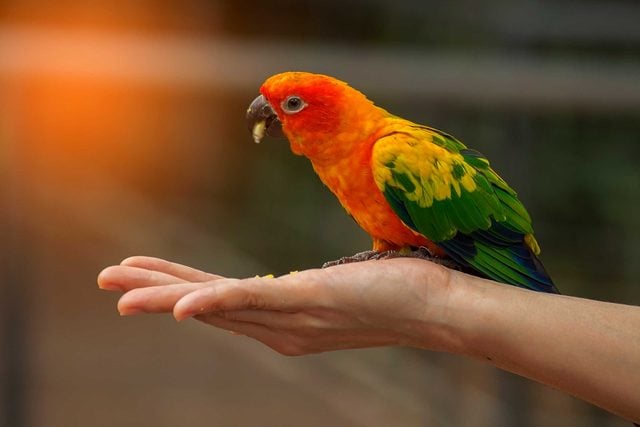The Science Behind Emotional Support Animals and Whether They Work
Updated: Apr. 09, 2020
Emotional support animals allegedly help some people with mental health conditions, like anxiety, cope, but do they really work?

Sarah Smith, 22, is a United States Marine police officer with an anxiety disorder that medication alone couldn’t manage. When a trip to a pet store turned into a solution for her anxiety issues, she discovered that emotional support animals (or ESAs), might look a bit different from the typical dog or cat. “I came across an African Senegal parrot, and we just clicked,” she says.
It wasn’t long before she noticed that her new parrot, Zoboomafoo, was very intuitive, she says. Smith adds her parrot could tell when her anxiety was high or she was having a panic attack. “He would sit on my shoulder and offer me kisses, whistles of encouragement, and provide me with distraction until my heart rate came back down and my anxiety was under control,” she says.
Research supports what Smith and Zoboomafoo have discovered: Pets, including birds, provide many benefits to those with mental health conditions, according to 2018 research published in BMC Psychiatry. But these animal companions are not without controversy. There is a growing trend of people like Smith seeking emotional support from animals. This has become a challenge since the guidelines for certification can be challenging for mental health professionals. Somebody has to certify that the animal is able to do what you’re asking it to do, notes Jeffrey Younggren, a forensic psychologist and clinical professor at The University of New Mexico’s Department of Psychiatry and Behavioral Sciences, who has published research to help formalize the current process.
The benefits of emotional support animals
The overall physical and mental benefits of living with an animal have been known for years. Animals are good for us. Besides being sources of emotional support, they alleviate worry and provide companionship for those prone to feelings of isolation and loneliness. Moreover, studies show that pets tend to increase their owner’s level of activity, encourage them to seek mental health help, reduce chronic pain, and improve the overall quality of life. However, studies on the benefits of companion animals have come under criticism for being less than rigorous: A report published in the International Journal of Evidence-Based Healthcare claimed the research relies too much on the reports of patients and other anecdotal evidence.
The jury may still be out, but owners are convinced
Smith is certainly not alone in her appreciation for her emotional support animal—according to the National Service Animal Registry (NSAR), more than 200,000 pets have been registered. Any pet can qualify to be one, reports the group, including rabbits, snakes, ducks, and ferrets, and they can be any age. The only criteria are that the animal’s presence reduces symptoms associated with that person’s emotional or mental disability, and—this part is key—the animal does not create a nuisance in public. It may be challenging for people to find providers willing to testify to an animal’s safety and to carry that liability. Still, some people may even have more than one emotional support animal.
Emotional support animal rights vary from state to state
Numerous companies have sites that provide registration cards and ESA identification vests for a fee. According to the Americans With Disabilities Act, or ADA, emotional support animals are not considered service animals, because they are not trained for a specific task (such as leading the blind) to assist a disabled person.
There are many ways to register a pet. Smith was able to get an emotional support animal letter from a mental health practitioner to allow Zoboomfoo to travel with her. Some may argue whether an emotional support animal should have the same rights as a trained service dog. However, the bond between animals and humans is beneficial and meaningful. “He gives me the boost of confidence I need to get through a crowded store or drive in the rain and dark,” Smith says of Zoboomfoo. He flies with her too, staying with her through the airport and sitting on her lap during flights. “Something that once caused me extreme stress is now just a trip with a trusted friend,” she says.
Next, read these tips on how to manage anxiety and panic disorder.

